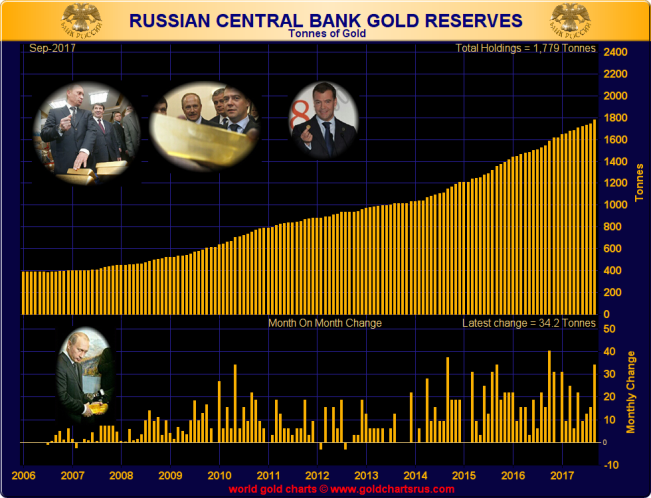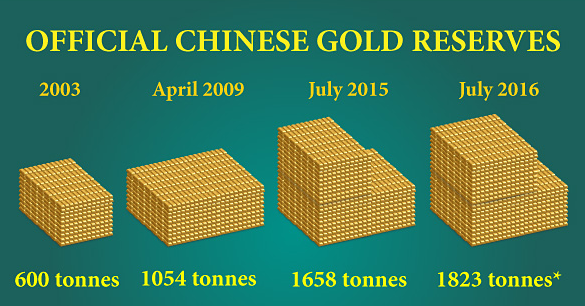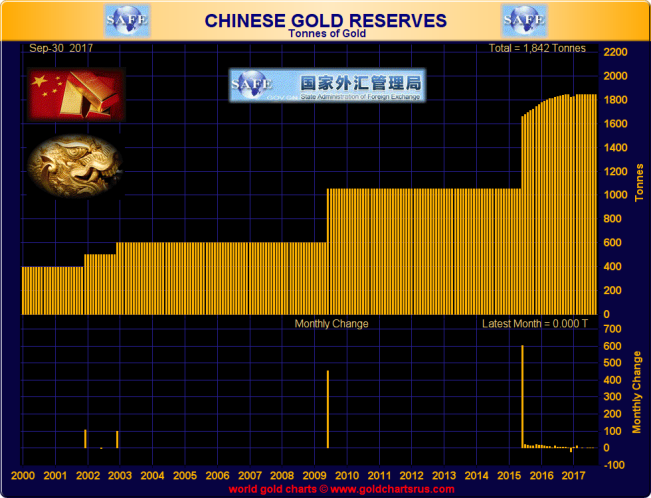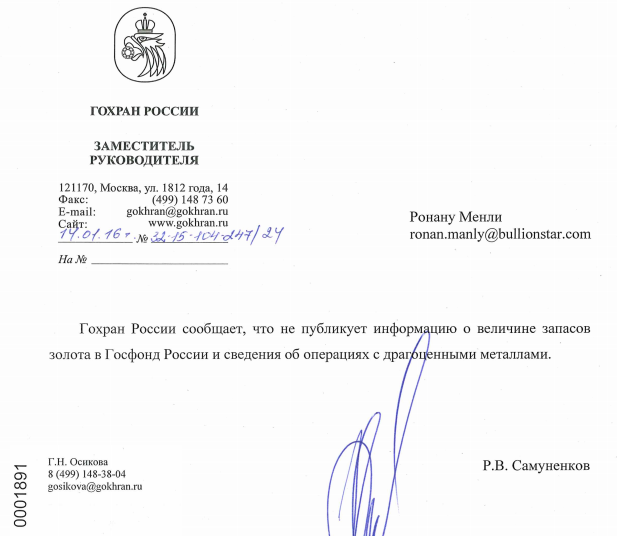Neck and Neck: Russian & Chinese Official Gold Reserves
Note: This article has now been updated to reflect the fact that during September 2017, the Bank of Russia added a further 1.1 million ounces of gold (34 tonnes) to its gold reserves. This information was released by the Bank of Russia on Friday 20 October.
Official gold reserve updates from the Russian and Chinese central banks are probably one of the more closely watched metrics in the gold world. After the US, Germany, Italy and France, the sovereign gold holdings of China and Russia are the world’s 5th and 6th largest. And with the gold reserves ‘official figures’ of the US, Germany, Italy and France being essentially static, the only numbers worth watching are those of China and Russia.
The Russian Federation’s central bank, the Bank of Russia, releases data on its official gold holdings in the Bank’s monthly “International Reserves and Foreign Currency Liquidity” report which is published towards the end of the third week of each month, and which confirms gold reserve changes as of the previous month-end.
The Chinese State releases data on its official gold holdings via a monthly “Official Reserve Assets” report published by the State Administration of Foreign Reserves (SAFE) that is uploaded within the Forex Reserves pages of the SAFE website. This gold is classified as held by the Chinese central bank, the People’s Bank of China (PBoC). The SAFE report is published during the 2nd week of each month, reporting on the previous month-end.
In both reports, official gold reserves (i.e. monetary gold) are specified in both US Dollars and fine troy ounces. Monetary gold is gold that is held by a central bank or other monetary authority as a reserve asset on a central bank’s balance sheet.
Delta: 63 Tonnes
For the Bank of Russia, its latest report, published on 19 September 2017 addressing August month-end, shows the Bank holding 57.2 million fine troy ounces of gold (1779 tonnes). For the Chinese State, the latest SAFE release is reporting Chinese official gold reserves of 59.24 million ounces (1842 tonnes).
Russian gold reserves, as officially reported, now total 1779 tonnes, and are now just 63 tonnes shy of the ‘official’ gold reserves of the Chinese central bank. Given that the Bank of Russia is expected to add about another 36 tonnes of gold to its official reserves during the remainder of 2017, then if the Chinese State does not reveal any increase in its ‘official’ gold reserves between now and the first quarter of 2018, Russia will most likely surpass China in terms of official gold reserves by April 2018.
While its possible and probable that the Chinese State / PBoC really holds more gold than it claims to hold, any upcoming scenario in which the Bank of Russia surpasses the People’s Bank of China in terms of gold holdings would at least be symbolic in terms of international monetary developments, and would be sure to generate some chatter in the financial press.
Although the official gold reserves of these two key nations are now nearly neck and neck, there are still some interesting contrasts between them, not least the way in which the Bank of Russia’s reported gold holdings have been steadily increasing month on month, while the reported gold holdings of the People’s Bank of China have remained totally unchanged for nearly a year now, since the end of October 2016.
Therefore the situation which is now emerging, i.e. the distinct possibility that Russian official gold reserves will surpass those of China something in early 2018, is a situation which is emerging precisely because the Russian Federation keeps adding to its gold reserves, while the Chinese State seemingly does not.
Differing Styles of Communication
The routes via which these two strategically important nations have amassed their official gold reserves are also quite different, at least at a public reporting level.

It wasn’t so long ago (2007) that the gold reserves of the Russian Federation were still in the region of 400 tonnes. However, beginning in about the third quarter of 2007, the Bank of Russia began a concerted campaign to rapidly expand its official gold holdings, a trend which never subsided and which has been ongoing now for exactly 10 years. By early 2011, official Russian gold reserves had exceeded 800 tonnes. By the end of 2014, the Bank of Russia was reporting holding more than 1200 tonnes of gold. And by the end of 2016, Russian official gold were more than 1600 tonnes. For full details on the Bank of Russia’s gold holdings, including gold storage, gold reserve management, gold purchases and Russian government views on gold, see “Bank of Russia, Central Bank Gold Policies" at BullionStar’s Gold University.
From the above chart, it can be seen that during 2014, 2015 and 2016, respectively, the Bank of Russia added 171 tonnes, 208 tonnes, and 199 tonnes to its gold reserves, or in total 578 tonnes over a 3 year period. In 2017, with the Bank of Russia having added another 164 tonnes of gold for the year to end of August, its official gold reserves now stand at 1779 tonnes.
The route to the Chinese State accumulating 1842 tonnes of gold is a different one to that of the Russians, again at least from a publicly reported angle. While the Bank of Russia has historically published changes to its gold reserves on a monthly basis, the Chinese central bank has chosen to remain very secretive, and between 2001 and mid 2015 had only issued four public updates addressing the size and growth of its gold reserves. These 4 updates were as follows:
- 4th Quarter 2001: From 394 to 500 tonnes: A 106 tonne increase
- 4th Quarter 2002: From 500 to 600 tonnes: A 100 tonne increase
- April 2009: From 600 to 1,054 tonnes: A 454 tonne increase
- July 2015: From 1,054 to 1,658 tonnes: A 604 tonne increase
Beginning in July 2015, however, the Chinese State started to report changes in its official gold reserves on a monthly basis, and by July 2016 was reporting 1823 tonnes of official gold holdings. The following graphic, taken from a BullionStar infographic on the Chinese gold market, illustrates the sporadic reporting of Chinese official gold reserves between the early 2000s and July 2015. Note that between July 2016 and October 2016, the Chinese State through SAFE reported that the PBoC had acquired another 19 tonnes of gold, taking its total reported gold reserves to 1942 tonnes as of the end of October 2016.

The sparse official reporting by the Chinese is also clear in the below chart from the GoldChartsRUS website, which shows cumulative holdings of monetary gold by the People’s Bank of China (PBoC) between 2000 and 2017. Looking at the top panel of the chart, it can be seen that between 2001 and 2015, there were only 4 distinct jumps in the quantity of gold held by the PBoC.
This was followed by a period of about 15 months from July 2015 during which SAFE reported small monthly accumulations in PBoC’s gold holdings, as can be seen from the gradual increases in the bars in the top panel from July 2015 to October 2016, and the corresponding presence of frequent activity in the monthly changes in the lower panel of the chart.

By September 2016, Chinese State gold reserve holdings had reached 59.11 million ounces. In October 2016, the SAFE report announced that Chinese official gold holdings had reached 59.24 million ounces, a 0.13 million ounce increase from the previous month. However, then something unusual happened, at least in terms of monthly updates. Since October 2016, Chinese official gold reserves have not changed at all. The SAFE updates are still published each month, but the gold holdings figure has remained unchanged at 59.24 million ounces (1842 tonnes).
Therefore, for nearly a year now, the Chinese authorities are signalling that they have not acquired any new gold. At least that is what they want the public to believe. Hence the constantly recurring headlines from the financial media, such as this one from Reuters a week ago, “China gold reserves steady at 59.24 mln ounces at end-September – central bank”.
But is it true that China only holds 1842 tonnes of gold and that it has not been active during the last year in continuing to accumulate monetary gold as part of its reserve assets? And for that matter, is it the case that the Bank of Russia and Russian Federation only hold 1779 tonnes of monetary gold?
While its difficult to know for sure, it is possible that the People’s Republic of China and the Russian Federation both hold additional gold that is not reported by their monetary authorities. This is so for multiple reasons, including the opaque ways in which these monetary gold reserves are accumulated, the traditional secrecy of both governments, and the fact that both countries have access to other investment pools that might hold gold that can be transferred at short notice into the respective central banks’ official gold holdings.
How Much Gold could the Chinese State really have?
The historical track record of the Chinese State in sporadically communicating the size of its monetary gold holdings shows that there has often been a large gulf between the true size of its gold reserves and what the Chinese claimed to have via its piecemeal and rare updates. For example, even based on its official numbers, the PBoC accumulated over 600 tonnes of gold between April 2009 and July 2015 but did not reveal this until July 2015.
The nearly year-long hiatus between October 2016 and the present, during which the Chinese authorities, via SAFE, claim that the PBoC’s gold holdings have remained at 1842 tonnes, could be true, but only in so far as the Chinese State does not wish to inform the world about its sovereign gold reserves. Beyond this, the true gold holdings of the Chinese central bank may be significantly higher than even official published figures suggest.
There is very little transparency into how the Chinese authorities accumulate monetary gold. In July 2015, when SAFE announced the first update to its gold holdings since 2009, it stated that the “major channels of accumulation” of gold were from purchases in foreign markets, domestic gold production, domestic scrap sources, and other transacting in the domestic market. But beyond this, the Chinese authorities never comment on where they source gold from.
There is lots of evidence that the Chinese State purchases significant quantities of gold in the international market, including in the London Gold Market, and then monetises this gold (i.e. classifies it as monetary gold) , before transporting it back to Beijing. See “PBoC Gold Purchases: Secretive Accumulation on the International Market”, at BullionStar Gold University for further details.
The Chinese State is also a possible candidate for having purchased a tranche of the IMF’s gold during IMF gold sales in 2010. See BullionStar blog “IMF Gold Sales – Where ‘Transparency’ means ‘Secrecy’" for further details.
There are also plenty of other State entities and state controlled entities in addition to the Chinese central bank that could conceivably be holding gold reserves that could in time be reclassified as PBoC gold, and brought into the sphere of reporting. See section “Gold Transfers from other Chinese State entities" in BullionStar Gold University article “Gold Policies of the People’s Bank of China" for further details.
There is also evidence to suggest the Chinese State is really buying about 500 tonnes of gold per year, and that it has a first step target of holding at least 4000 tonnes of gold. This evidence, which is from 3-5 years ago, comes from senior people in the China Gold Association (CGA). See section “How much gold might the PBoC be buying each year?" in article PBoC Gold Purchases.
A gold reserves-to-FX reserves ratio of 5% would currently put Chinese state gold holdings at nearly 4000 tonnes. A gold-to-GDP ratio of about 1.77%, which is the equivalent of the gold-to-GDP ratio of the US, would currently put Chinese state gold holdings at nearly 5000 tonnes of gold.
Russia: Golden Pipelines and Stockpiles
In its “Methodological Notes to International Reserves of the Russian Federation“, the Bank of Russia defines “monetary gold” as:
“standard gold bars and coins with a purity of at least 995/1,000 held by the Bank of Russia and the Government of the Russian Federation. It comprises gold in vault, en route and in allocated accounts, including that which is held abroad. The item monetary gold includes unallocated gold accounts with non-residents.”
The primary source of gold flowing to the Bank of Russia comes from Russian gold mining production, with the Russian Federation acquiring a large percentage of domestic gold mining production each year. In practice, a small group of state influenced Russian banks are authorised to intermediate between the gold mining companies and the State, acting as a gold pipeline between the mines and the Bank of Russia / Government. These banks finance the mining companies, purchase their gold output , have it refined into gold bars by Russian gold refineries, and then offer this gold to the Russian State.
Some of these banks include Sberbank, VTB, Gazprombank and Otkritie. For details see section “Russian Banks as bulk buyers of Russian Gold” in the Russian gold market article in BullionStar’s Gold University.
But its possible that some of this gold ends up not with the Bank of Russia, but with other Russian State entities, one of which is the “Gosfund” or “Precious Metals and Gems fund" operated by “The Gokhran".
This Gosfund could be buying a portion of Russian gold mining output, stockpiling it, and intermittently releasing some of its stockpile to the Bank of Russia. When I asked the Gokhran last year could it reveal its gold holdings, the Gokhran replied to me that “it does not publish information about the amount of gold reserves in the Russian Gosfund nor any data about its precious metal operations.” See letter reply from Gokhran below (for those who can read Russian).

Conclusion
Given the high degree of opacity with which both the Russian State and Chinese State accumulate monetary gold, and the fact that they both can probably tap additional gold stockpiles for boosting their official gold reserves, it will be interesting to see whether China, through SAFE, announces any increase in the PBoC’s gold holdings between now and the end of Q1 2018.
Because if China does not do so, the Russian Federation will soon have the distinction of being the world’s 5th largest gold holder, pushing China into 6th place. Will China update its gold holdings before the end of 2017, or at least by early 2018? Nothing is certain, but with an ‘official’ difference of only 63 tonnes of gold between them, the race is on.
Popular Blog Posts by Ronan Manly
 How Many Silver Bars Are in the LBMA's London Vaults?
How Many Silver Bars Are in the LBMA's London Vaults?
 ECB Gold Stored in 5 Locations, Won't Disclose Gold Bar List
ECB Gold Stored in 5 Locations, Won't Disclose Gold Bar List
 German Government Escalates War On Gold
German Government Escalates War On Gold
 Polish Central Bank Airlifts 8,000 Gold Bars From London
Polish Central Bank Airlifts 8,000 Gold Bars From London
 Quantum Leap as ABN AMRO Questions Gold Price Discovery
Quantum Leap as ABN AMRO Questions Gold Price Discovery
 How Militaries Use Gold Coins as Emergency Money
How Militaries Use Gold Coins as Emergency Money
 JP Morgan's Nowak Charged With Rigging Precious Metals
JP Morgan's Nowak Charged With Rigging Precious Metals
 Hungary Announces 10-Fold Jump in Gold Reserves
Hungary Announces 10-Fold Jump in Gold Reserves
 Planned in Advance by Central Banks: a 2020 System Reset
Planned in Advance by Central Banks: a 2020 System Reset
 Gold at All Time Highs amid Physical Gold Shortages
Gold at All Time Highs amid Physical Gold Shortages






 Ronan Manly
Ronan Manly 0 Comments
0 Comments










